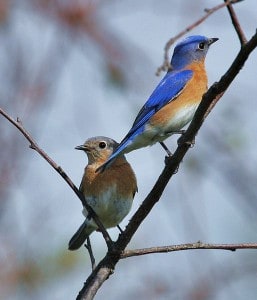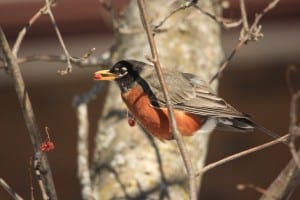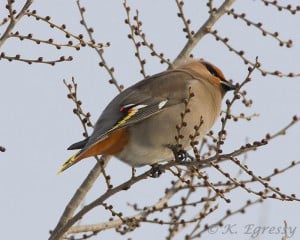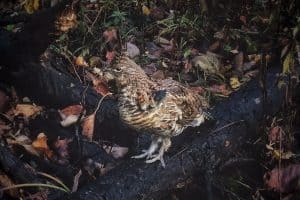Between mid-December and early January, birders in over 2000 localities across North, Central and South America took a break from the holiday festivities to spend a day outside, identifying and counting birds. Dating all the way back to 1900, the Christmas Bird Count is one of the longest-running Citizen Science projects in the world. The information collected by thousands of volunteer participants forms one of the world’s largest sets of wildlife survey data. The data are used daily by conservation biologists and naturalists to assess the population trends and distribution of birds. The counts are organized at the local level, often by a birding club or naturalist organization.
The count area is always a circle, measuring 24 kilometres in diameter. The circle is then sub-divided into sectors, each of which is covered by a group of birders. This involves driving as many of the roads in the sector as possible and walking or skiing into off-road areas of different habitat types. The basic idea is to identify and count – as accurately as possible – every bird seen or heard.
Once again this year, two counts took place locally – one centred in Peterborough and the other in Petroglyphs Provincial Park. Martin Parker of the Peterborough Field Naturalists organized the Peterborough count, while Colin Jones compiled the Petroglyphs count.
Peterborough Count
The 65th Peterborough Christmas Bird Count was held December 18 under cold but sunny conditions. Forty-one members and friends of the Peterborough Field Naturalists spent all or part of the day in the field, while seven others kept track of birds visiting their feeders. One observer was also out before dawn listening for owls.
By the end of the day, participants found 13,860 individual birds, which is a new high. A total of 59 species was recorded. There were two new species for the count, a Horned Grebe and two Eastern Bluebirds. The grebe was found on the Otonabee River at Millennium Park, while the bluebirds turned up near the intersection of the Lang-Hastings Trans Canada Trail and County Road 35. The grebe and bluebirds bring the total number of species found on the count its 65-year history to 130.
The biggest story of this year’s count, however, was the huge number of American Robins. These birds clearly missed the memo that it was time to migrate! The 1,943 robins recorded more than doubled the previous high of 759 tallied in 2011. Observers described seeing flock after flock of robins flying across roads and fields to thickets full of wild grape – a favourite winter food and the main reason why so many robins took a pass on flying any further south. If the birds can get enough to eat, cold is not a problem. It will be interesting to see if there is sufficient food to keep the robins remain here until spring.
Record highs were also tallied for Bald Eagles (5), Eastern Screech Owls (4), American Crows (953), White-breasted Nuthatches (120), and Dark-eyed Juncos (543). Previous highs were tied for Sharp-shinned Hawks (5) and Red-bellied Woodpeckers (8).
Three rarely seen species also turned up, namely a Lesser Black-backed Gull, a Snow Goose and a Brown Thrasher. This was only the second time the latter two species have ever been found on the count. Thrashers are usually in Louisiana at this time of year!
As is the case every year, there were also some notable low numbers. For instance, observers only found only 71 Canada Geese. This was because cold weather just before the count had reduced the amount of open water. As has been the pattern in recent years, the number of Great Horned Owls (1) and Ruffed Grouse (2) was also very low. To put this into context, 82 grouse were recorded in 1979. It is well known, however, that grouse numbers fluctuate a great deal from year to year and even decade to decade. The factors responsible for these periodic fluctuations remain poorly understood. As for Great Horned Owls, the Canadian population has declined by over 70% since the 1960s.
The overall data for the Peterborough count is as follows: Snow Goose 1, Canada Goose 71, American Black Duck 5, Mallard 1006, Long-tailed Duck 1, Bufflehead 1, Common Goldeneye 95, Hooded Merganser 2, Common Merganser 1, Ruffed Grouse 2, Wild Turkey 88, Horned Grebe 1, Sharp-shinned Hawk 5, Cooper’s Hawk 1, Northern Goshawk 2, Bald Eagle 5, Red-tailed Hawk 25, Rough-legged Hawk 2, Ring-billed Gull 71, Herring Gull 131, Lesser Black-backed Gull 1, Great Black-backed Gull 1, Rock Pigeon 1006, Mourning Dove 515, Eastern Screech-Owl 4, Great Horned Owl 1, Belted Kingfisher 1, Red-bellied Woodpecker 8, Downy Woodpecker 64, Hairy Woodpecker 40, Northern Flicker 5, Pileated Woodpecker 7, Merlin 2, Peregrine 1, Northern Shrike 3, Blue Jay 261, American Crow 953, Common Raven 29, Black-capped Chickadee 1722, Red-breasted Nuthatch 15, White-breasted Nuthatch 120, Brown Creeper 6, Eastern Bluebird 2, American Robin 1943, Brown Thrasher 1, European Starling 2674, Bohemian Waxwing 4, Cedar Waxwing 220, Snow Bunting 1010, American Tree Sparrow 344, Dark-eyed Junco 543, White-throated Sparrow 2, Northern Cardinal 104, Brown-headed Cowbird 1, House Finch 44, Purple Finch 1, American Goldfinch 533, and House Sparrow 147.
Petroglyph Count
The 31st Petroglyph Christmas Bird Count took place on December 27, in less than favourable weather conditions. The day was dull and overcast with strong winds and intermittent periods of light snow and freezing drizzle. The strong winds made listening difficult for the 24 participants. A successful Christmas bird count depends not only on seeing the birds but also on hearing them. Calm days are therefore best. Only 28 species were found, which is six lower than the 10-year average. The number of individual birds (1937) was also below average.
Although no new species were recorded, there were some notable sightings. A record 318 Bohemian Waxwings was more than four times the previous high of 76. A Cooper’s Hawk was recorded for only the fourth time on the count, and a Rough-legged Hawk turned up for only the sixth time. The 11 American Robins counted was only two shy of the previous high.
As for low counts, only six Ruffed Grouse were recorded. This is well below the 10-year average of 22 and the count high of 77. Blue Jay numbers were down, too, with only 74 putting in an appearance. The 10-year average is 271, and count high is 653. A poor acorn crop probably explains the Blue Jay’s relative scarcity. Most jays simply chose to migrate south this year in search of more abundant food. Numbers of Pileated Woodpeckers, Red-breasted Nuthatches and Golden-crowned Kinglets were also much lower than average.
A worrisome miss was the Gray Jay. A pair was visiting a feeder just before the count but was not present on count day. An average of five birds was recorded every year up until 2009. Since then, however, they have only been tallied once on the day of the count. Gray Jays are one of many species that are expected to decrease in number as the climate warms, especially at the southern edge of their range such as here in the Kawarthas.
No Barred Owls were found this year, either. This very vocal species had been recorded every year since 1995 except for 2012 and this year. With the exception of reasonably good numbers of American Goldfinch (326) and Evening Grosbeaks (44), no other finches were found.
The overall data for the Petroglyph count is as follows: Ruffed Grouse 6, Wild Turkey 43, Bald Eagle 5, Cooper’s Hawk 1, Red-tailed Hawk 1, Rough-legged Hawk 1, Rock Pigeon 34, Mourning Dove 5, Downy Woodpecker 23, Hairy Woodpecker 25, Pileated Woodpecker 4, Northern Shrike 1, Blue Jay 74, American Crow 10, Common Raven 65, Black-capped Chickadee 676, Red-breasted Nuthatch 32, White-breasted Nuthatch 92, Brown Creeper 24, Golden-crowned Kinglet 4, American Robin 11, European Starling 45, Bohemian Waxwing 318, American Tree Sparrow 22, Dark-eyed Junco 19, Snow Bunting 26, American Goldfinch 326, and Evening Grosbeak 44. A Gray Jay was also seen during the count period but not on the day of the count.
Kids Count
In order to help young people develop an interest in birding, the third annual Junior Christmas Bird Count (CBC 4Kids) also took place on the same day as the Peterborough count. Organized by Lara Griffin, the Peterborough Field Naturalist Juniors scoured the grounds and nearby trails of the Camp Kawartha Environment Centre on Pioneer Road. The birds they found were added to the Peterborough count data. The junior event incorporates many of the same features as the adult version. However, it is far less rigorous and designed more like a game.
Great Backyard Bird Count
If you are interested in contributing to Citizen Science and maybe introducing your children or grandchildren to birding, consider taking part in the Great Backyard Bird Count (GBBC). This year, it is taking place February 17-20. The GBBC engages bird watchers of all levels of expertise to create a real-time snapshot of the whereabouts and relative abundance of birds in mid-winter. Anyone can participate. Simply tally the numbers and kinds of birds you see for at least 15 minutes on one or more days of the count. You can count from any location, anywhere in the world! Go to gbbc.birdcount.org for details.



